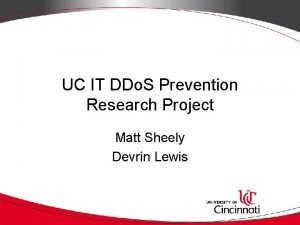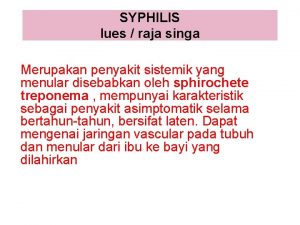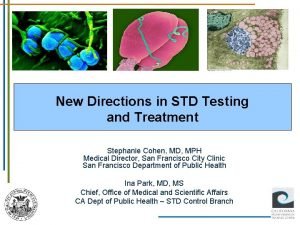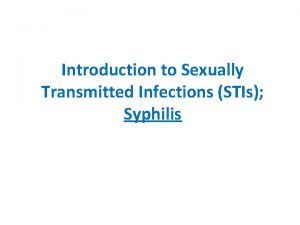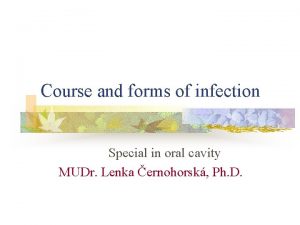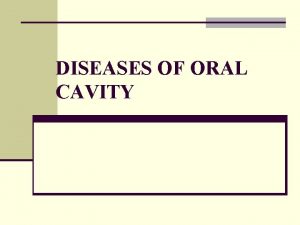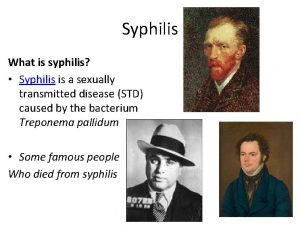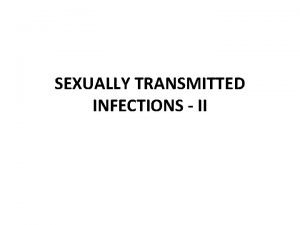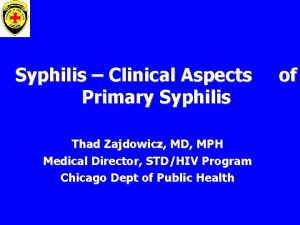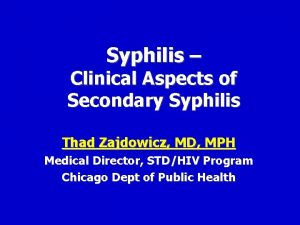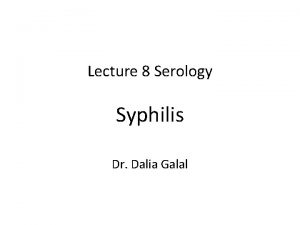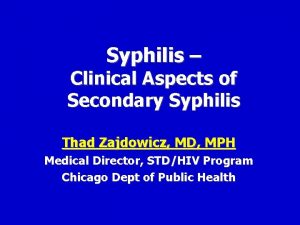Syphilis The Great Mimic What is Syphilis Caused




















- Slides: 20

Syphilis The Great Mimic

What is Syphilis? • Caused by the bacterium Treponema pallidum • Time between infection and start of first symptom is 10 -90 days • Diagnosed by – Dark field microscopy of material taken from a lesion or lymph node – Serologic tests (RPR & VDRL)1 1. CDC. 2014. STD treatment guidelines.

Stages of Syphilis • Disease has 4 distinct phases: – Primary – Secondary – Latent (early & late) – Tertiary

How Do I Get Syphilis? • Bacteria enter body through minute abrasions in skin • Transmitted through contact with moist lesions, especially during sexual activity • Rate of transmission from infected sexual partner is about 30%-60%1 • Primary, secondary, and early latent stage account for nearly all transmission • Syphilis may also be acquired congenitally (at birth) 1. Augenbraun M. 2003. In: Dale DC.

Syphilis • Syphilis has been around since at least the 15 th century. • National public reporting of syphilis cases began in 1941. • In the year 2000, the rate of primary and secondary (P&S) syphilis hit an all time low. • In 2013, the total case counts (all stages) were the highest recorded since 1996. • From 2012 to 2013, there was a 13. 1% increase in overall cases. .

Syphilis and MSM • 75% of primary and secondary syphilis in 2013 was associated with men having sex with men (MSM). • Syphilis cases among MSM are characterized by high rates of HIV co-infection and high-risk sexual behaviors. • In 2006, the rate was highest among men ages 35 – 39 years. • In 2013 the rate was highest in men 20 -29 years old. CDC, “ 2013 STD Surveillance Syphilis”

Syphilis and Youth • 20% of all newly diagnosed cases are in young people, ages 15 – 24. 1 • Racial disparities in young people ages 15 – 19 – Rates among black males were 11. 7 times higher than white males in the same age group. – Rates among black females were 18. 2 times higher than white females in the same age group. CDC, “Sexuallly Transmitted Infections Among Young Americans”

Reported Cases of Syphilis Source: CDC. 2010. STD Surveillance.

What is Primary Syphilis? • Single or multiple sores (chancres) • Firm, round, painless; indicates point of bacterial entry • Typically occurs on genital skin and mucosa • May also occur in mouth, hands, or other parts of the body • Chancre heals by itself in 3 -6 weeks • Neurosyphilis can occur during any stage of syphilis, including primary and secondary syphilis. 1

Vaginal opening Syphilis chancre

Syphilitic Chancre, Mouth

Syphilitic Chancre, Female Abdomen

Syphilitic Chancre, Male Syphilis chancre

What is Secondary Syphilis? • Symptoms are caused by the spread of the bacteria • Fever, sore throat, rash, lymph gland swelling, loss of hair 1 • External genital lesions called condyloma lata • Lesions resolve in 3 -12 weeks 2 1. Augenbraun M. 2003. In: Dale DC. 2. Sparling PF. 2008. In: Holmes KK, et al.

What is Latent Syphilis? • • Latent stage can be divided into early and late stages Mostly asymptomatic and contagious Early latent stage usually during first year of infection One-fourth of patients in early latent stage have a relapse (ie, become symptomatic again) • Relapse is rare in latent syphilis • May resolve by itself or advance to the tertiary stage 1 1. Sparling, PF. 2008. In: Holmes KK, et al.

What is Tertiary Syphilis? • Occurs in 1/3 of the cases, months or years after latency 1 • Causes walls of major arteries to weaken and balloon out; these aneurysms can rupture and may be fatal • Affects the brain and its coverings to cause paralysis, mental confusion, insomnia, and headaches • Gummas - destructive lesions in skin, bones, and other organs 2 1. Augenbraun M. 2003. In: Dale DC. 2. Sparling PF. 2008. In: Holmes KK, et al.

Stages of Syphilis (approximate duration) 1 -3 wks Incubation 3 -6 wks Primary 3 -12 wks Secondary < 1 yr Early latent 1 -5 yrs Late latent many years Tertiary Infectious & symptomatic Noninfectious & symptomatic Infectious & asymptomatic Noninfectious & asymptomatic

How is Syphilis Treated? • Effectively treated with antibiotics (penicillin) • Repeated tests are important to confirm cure • 2 -to-5 fold increased risk of HIV infection with syphilis 1 • Syphilis is on the increase in HIV positive homosexual males 2 • All patients with syphilis should be tested for HIV 1. CDC. 2010. Fact Sheet. 2. CDC. 2010. STD Surveillance.

Reducing Syphilis Risk • Syphilis is a dangerous STI • 100% consistent use of condoms may reduce the risk of transmission, but does not eliminate the risk. 1 • Screening of all pregnant females is recommended 2 • All infants born to infected mothers should be treated 2 1. Koss. 2009. Sexually Trans. Diseases 2. CDC. 2010. STD Treatment Guidelines.

Avoiding Syphilis • For unmarried individuals, sexual abstinence is the only practical and certain way to avoid syphilis • For those who choose to be sexually active, a marriage (mutually faithful, life-long relationship with an uninfected sexual partner) is the healthiest choice
 The great pretender syphilis
The great pretender syphilis The great pretender syphilis
The great pretender syphilis What caused the great schism of 1378
What caused the great schism of 1378 Mimic octopus transformation
Mimic octopus transformation Ddo mimic vendor
Ddo mimic vendor Mimic poison dart frog
Mimic poison dart frog Mimic microwave
Mimic microwave Mimic octopus transformation
Mimic octopus transformation Mimic poison dart frog
Mimic poison dart frog Syphilis titer chart
Syphilis titer chart Mimic poison dart frog
Mimic poison dart frog Primary somatic sensory
Primary somatic sensory Syphilis diagnostic test
Syphilis diagnostic test Bacteria causing syphilis
Bacteria causing syphilis Hemoagglutination
Hemoagglutination Syphilis genitalis
Syphilis genitalis Iregulair
Iregulair Chlamydia treatment
Chlamydia treatment Pathophysiology of syphilis
Pathophysiology of syphilis Syphilis on the lips
Syphilis on the lips Condyloma lata syphilis
Condyloma lata syphilis




